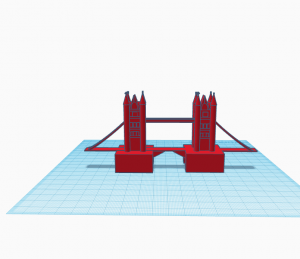This project was all about calculating the surface area and volume of 3D shapes. Our driving question is “How can we design an object to optimize its shape?”. To answer the driving question we had to create 3D shapes in groups from 1-3 people then we had to create one or more 3D shapes on an app called Tinkercad. The object (or objects) had to be created to optimize surface area or volume. After we designed our objects they were supposed to be printed out in the school 3D printer which we were sadly unable to do.
With a group of two of my classmates Clare and Jocelyn, we created three objects of our choice that we all decided would be a famous European architecture.
The London Bridge (mine)
The leaning tower of Pisa (Jocelyn)
Big Ben (Clare)
I won’t mention all the milestones but here are the two I think most important ones. Milestone 2 was the milestone where we had to create our 3D shapes in Tinkercad. This was hard because we had to first learn how the use the app then needed to find a way to create our 3D shape. I had a lot of trouble because I kept getting kicked out of the app. In the end I was able to use that app to creat a pretty good replica of the London Bridge.
Milestone 3 was also important as that was when we had to hand in all the calculations. We had to find the surface area and volume of all the shapes to find the totals for the whole 3D object including the ratio of surface area to volume.
Curricular competencies
Applying and innovating: contribute to care for self, others, community, and world through personal or collaborative approaches.
I showed this competency not only when I used most of my class time well but
also when I helped my group and when they helped me. I helped my group a little in the building of our models, I also helped in the creation of the slideshow that we presented to our class. My group members helped me with the creation of my own 3D bridge.
Reasoning and Analyzing: Model mathematics in contextualized experiences. 
I showed this curricular competency when I found shapes within my 3D model. I had to figure out what some of the more difficult shapes were especially the tunnel under the bridge. I decided that it was a half cylinder that was going through the rectangular prism. In order to get the right volume and surface area of the rectangular prisms I had to minus the volume and add the surface area. My whole object together has more volume then surface area, with a 1.5:1 ratio.
Communicating and representing: Explain and justify mathematical ideas and decisions
I showed communicating and representing when I calculated, measured, and found the ratio of volume to surface area (1.5:1) of my 3D object. To do that I had to find the volume and surface area of all my shapes. I had to find a formula for each type of shape then I had to find all the heights, lengths, and other things like that. I also showed this competency when my group and I presented all of this information in class. We didn’t go into as much detail about our calculations in thePresentations as was required for the project.
In the end I was able to answer the driving question “How can we design an object to optimize its shape?”. we can design an object in Tinkercad and move and change shapes to optimize its volume or surface area. The hardest part of this project was all the calculations they all had several hard steps just to find the volume/surface area. Even though I wish it could have been 3D printed, I am very proud of all the shapes my group and I made.




